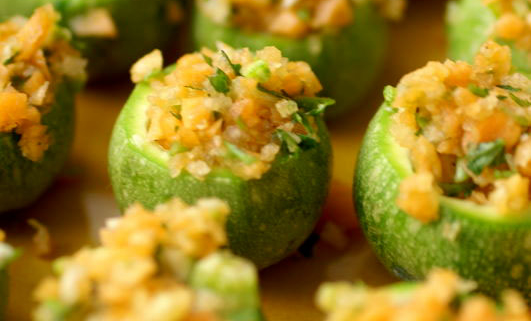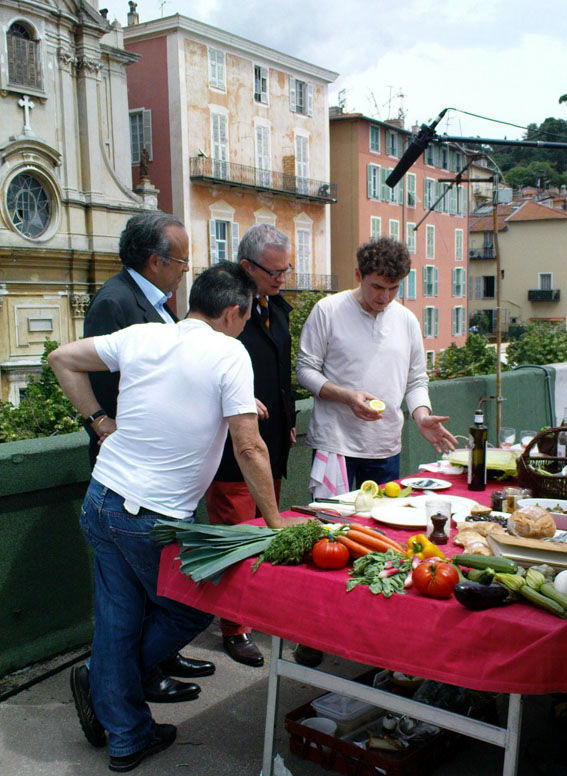Les petits farcis
I obviously have a soft spot for Les Petits Farcis, since I named my cooking classes after this Niçois dish with the hard-to-pronounce name.
What I love about these little stuffed vegetables, known affectionately as “les farcis” (“the stuffed”) in Nice, is how they reflect the personality of each cook. Like many Niçois dishes, they originated as a resourceful way to use up leftovers. Their charm lies in the size of the vegetables to be stuffed – the tinier the better – and the high proportion of vegetables to meat in the filling. Unlike the stuffed vegetables found in other parts of the Mediterranean, they never contain rice. The filling should be very soft, preserving the flavors and colors of the spring and summer vegetables that go into this dish.
Many bakeries, pasta shops and charcuteries in Nice sell les petits farcis, but they always seem to taste best when freshly made and served warm or at room temperature rather than hot. For a long time I’ve relied on a recipe that I adapted from Dominique Le Stanc, whose petits farcis are one of the reasons I keep going back to his Old Town bistro La Merenda. In this version, vegetables no bigger than a golf ball are stuffed with a mixture of onion, zucchini, bell pepper, mushrooms and ground veal flavored with garlic, parmesan and plenty of basil. The small amount of veal melts into the vegetables, so that you can barely tell the meat is there.
Recently, though, I was reminded of how endlessly adaptable this dish really is when I tasted a completely different, and staggeringly good, variation by Franck Cerutti. He had taken a rare day off to film a show with roving culinary reporter Jean-Luc Petitrenaud* and two other illustrious chefs, Jacques Maximin and Dominique Le Stanc, on the roof of a restaurant overlooking the Cours Saleya market. “I was up at 6am making these,” he said, showing me a dish of the tiniest stuffed eggplants, red peppers, onions, tomatoes and zucchini.
Franck starts by roasting a lamb shoulder – “herbs are not really necessary, though you could use some savory” – then using the finely chopped meat to make a separate filling for each vegetable. The zucchini are filled with zucchini, herbs and meat, the tomatoes with tomato, herbs and meat, and so on, though I noticed that some other vegetables had crept into the onion. The secret to good farcis, he says, is to pre-cook the vegetables and fillings until they are soft (“definitely not al dente”), then bake them together in an oven at 140 C (about 300 F) for about an hour with a little olive oil and water in the bottom of the dish. “Halfway through you should add a little water and baste them, to prevent the caramelized juices from burning.”
Though I haven’t yet tried to recreate his astonishing farcis, I have applied this last tip to my usual recipe to create juicier, more deeply flavored farcis. Because classic farcis are time-consuming, I’ve also been experimenting with a cheater’s version which comes from one of the small farmers at the market.
The Lucianos specialize in zucchini, and particularly zucchini flowers, and one day last week they had the smallest round zucchini I had ever seen. Mme Luciano told me that instead of precooking these zucchini, she stuffs them with a mixture of chopped raw zucchini, carrot, garlic and parsley and bakes them in a covered dish with water and some olive oil until they soften. She then removes the cover and lets them brown. This is just what I did and it worked beautifully, proving that rules are sometimes meant to be broken.





Leave a Reply
Want to join the discussion?Feel free to contribute!